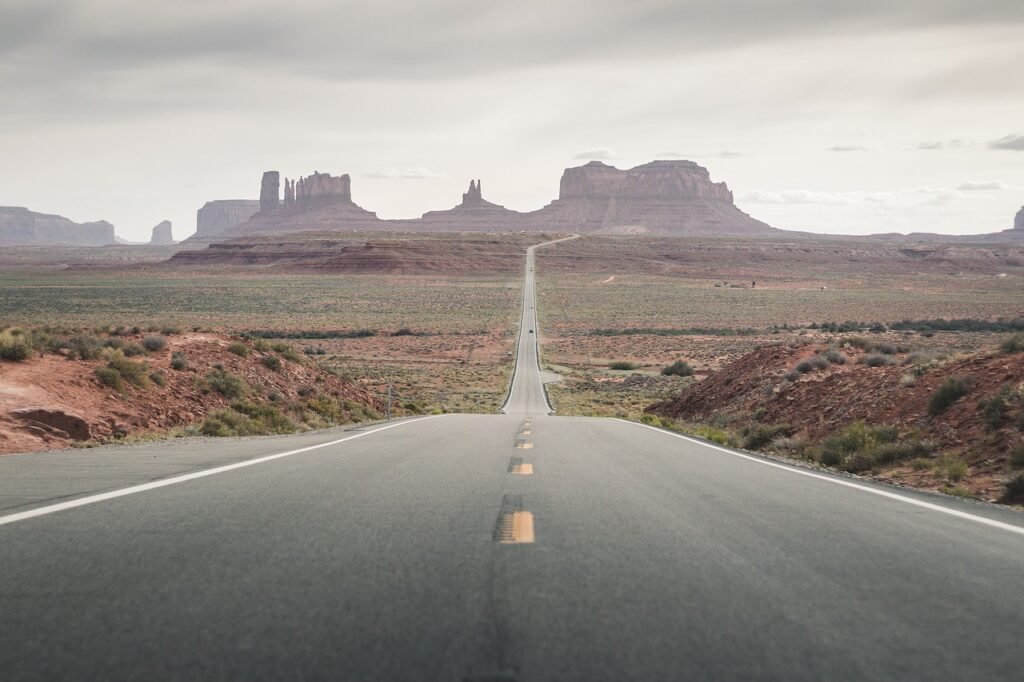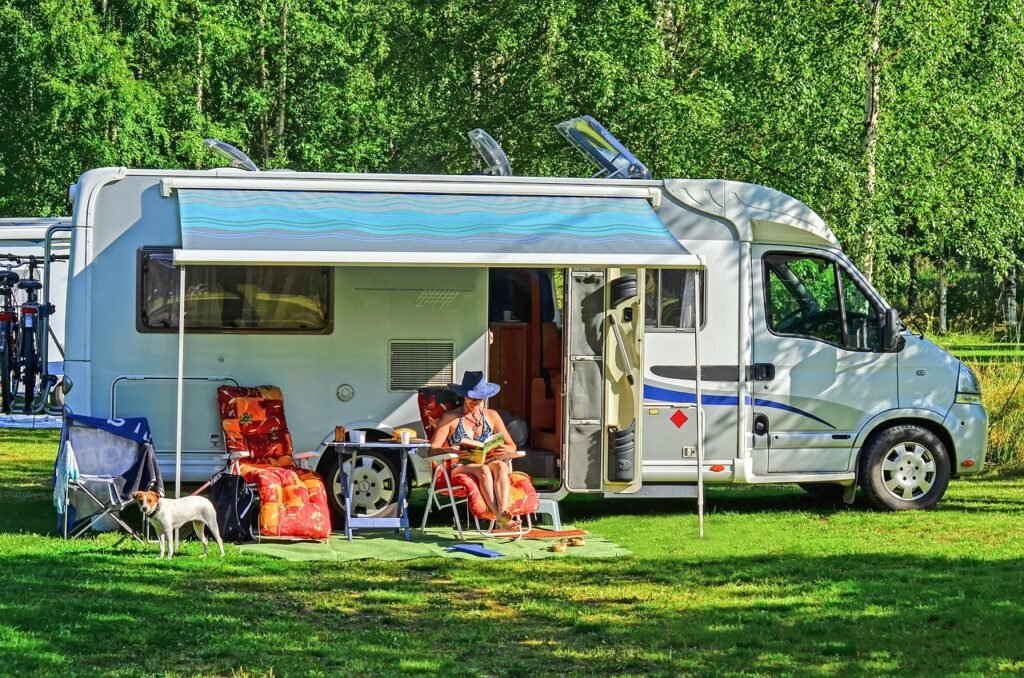This guide is designed for first-time RVers, especially those who have done some weekend or maybe even interstate road trips, but are new to the RV world. We’ll walk through everything you need to know to prepare for your first RV adventure. Whether it’s packing, planning your route, or learning how to manage your RV, we’ll make sure you feel confident and ready to roll by the end of this guide.
1. Choose the Right RV for Your Trip
Before you can plan anything else, the first step is choosing the right RV for your road trip. There are several different types of RVs, and the one you choose will depend on how many people are traveling, how much space you need, and how comfortable you are driving a larger vehicle.
Types of RVs
Class A Motorhomes: These are the largest RVs, often resembling a bus. They’re spacious and offer the most amenities, but they can also be intimidating to drive for first-timers.
Class B Motorhomes (Camper Vans): These are smaller and much easier to drive. They’re ideal for couples or solo travelers who don’t need a ton of space.
Class C Motorhomes: These fall somewhere between Class A and Class B. They’re built on a truck or van chassis and are a good option for families or groups of friends.
Towable RVs (Travel Trailers or Fifth Wheels): If you have a vehicle capable of towing, travel trailers can offer plenty of space without the need to drive a massive vehicle. You’ll need to get comfortable with towing though.
Renting vs. Buying
If you’re not ready to commit to buying an RV, renting is a great way to test the waters. There are websites like Outdoorsy and RVshare where you can rent RVs from private owners, or you can go through larger rental companies like Cruise America. Renting gives you the chance to try different types of RVs and figure out what works best for you.
Pro Tip: Practice Driving Your RV
Once you’ve chosen your RV, spend some time practicing driving it before your trip. If you’re renting, take it for a test drive in a nearby empty parking lot or quiet road. Get used to the turning radius, braking distance, and backing up. Trust me, once you’ve driven your RV around for a bit, you’ll start feeling much more comfortable behind the wheel.
2. Plan Your Route and Campgrounds

One of the best things about an RV road trip is the flexibility to change plans on the fly. However, for your first RV trip, it’s a good idea to have a general route and campground reservations planned in advance. This helps avoid the stress of figuring things out last minute and ensures you have a spot to park your RV each night.
Planning Your Route
Distance: For your first trip, aim for a manageable distance. Driving an RV can be more tiring than driving a regular car, so don’t plan to drive for 10 hours a day. Breaking the trip into shorter drives (4-6 hours a day) will make it much more enjoyable.
Scenic Routes: Part of the charm of RV travel is taking the scenic route. National parks, coastal highways, and mountain roads offer some of the most beautiful drives in the country. Apps like Roadtrippers can help you find scenic byways and points of interest along the way.
Gas Stations and Rest Stops: Be mindful of your RV’s fuel needs. It’s helpful to plan gas stops in advance, especially if you’re traveling through remote areas. Keep an eye out for truck stops—they often have larger parking areas that make it easier to refuel and take a break.
Booking Campgrounds
Private RV Parks: These parks offer full hookups (electricity, water, and sewage), Wi-Fi, laundry, and other amenities. They’re a great option for first-timers because they provide everything you need to keep your RV running smoothly.
State and National Park Campgrounds: These campgrounds are usually more rustic, often offering only basic hookups or none at all. However, they’re located in some of the most beautiful spots in the country, and there’s nothing quite like waking up to a view of the mountains or a peaceful forest.
Reservations: Many campgrounds require reservations, especially during peak season. Websites like ReserveAmerica and Recreation.gov allow you to book state and national park campgrounds, while private RV parks can usually be booked directly through their websites.
Pro Tip: Download RV Apps
There are several apps designed specifically for RV travelers. Apps like Campendium and AllStays can help you find campgrounds, RV parks, and dump stations along your route. They also offer reviews from other RVers, which is super helpful for first-timers looking for a great spot to stay.
3. Pack the Essentials (and Only the Essentials)
One of the biggest adjustments for first-time RV travelers is learning how to pack. While RVs offer more space than a regular car, it’s still important to pack efficiently and avoid bringing too much.
What to Pack
Clothing: Pack comfortable, weather-appropriate clothing, but don’t overdo it. Since you’ll have access to laundry facilities at many campgrounds, you don’t need to pack an outfit for every day. Stick to versatile pieces that you can mix and match.
Bedding and Towels: Most RVs come with a bed, but you’ll need to bring your own sheets, blankets, and pillows. Don’t forget towels for showering and swimming.
Cooking Supplies: RVs come equipped with a kitchen, but you’ll need to bring your own cookware, utensils, and dishes. A set of pots and pans, a cutting board, a good knife, and a couple of spatulas should cover most of your cooking needs. Don’t forget dish soap and sponges for cleanup!
Outdoor Gear: Camping chairs, a folding table, and a portable grill can make your time at the campsite more enjoyable. Many RV parks have picnic tables, but having your own gear gives you flexibility, especially if you’re boondocking (camping without hookups).
Toiletries: RVs come with a bathroom, so don’t forget to bring your own toiletries. Be mindful that RV bathrooms have smaller storage spaces, so stick to travel-sized bottles whenever possible.
Don’t Forget RV-Specific Items
Water Hose: You’ll need a freshwater hose to connect to the water supply at RV parks.
Sewer Hose: You’ll also need a sewer hose for emptying the black (toilet) and gray (sink/shower) water tanks. This might sound gross, but it’s just part of RV life. You’ll get used to it!
Leveling Blocks: Not all campsites are perfectly flat, so leveling blocks help ensure your RV is stable when parked.
Power Adapters: RV parks offer different types of electrical hookups, so having the right power adapter ensures you can connect to the available electricity.
Pro Tip: Create a Packing Checklist
A packing checklist is a lifesaver for RV trips, especially your first one. List everything you need, from kitchen supplies to RV gear, and check it off as you pack. This will help you avoid the dreaded “I forgot something” moment once you’re on the road.
4. Learn the Basics of RV Maintenance
Taking care of your RV is part of the adventure, and while it may seem intimidating at first, it becomes second nature with practice. Knowing a few basic maintenance tips will ensure your trip goes smoothly and avoid any roadside headaches.
Hooking Up at the Campground
When you arrive at the campground, there are three main things to hook up: electricity, water, and sewage.
Electricity: Most RV parks provide 30- or 50-amp electrical hookups. Simply plug your RV’s power cord into the appropriate outlet. Be sure to use a surge protector to avoid any electrical damage.
Water: Connect your freshwater hose to the campground’s water spigot and to your RV’s water inlet. This will provide running water to your sinks, shower, and toilet.
Sewage: Connect your sewer hose to the RV’s black and gray water outlets, then to the campground’s sewage hookup. Always empty the black water tank first (the one from the toilet), followed by the gray water tank (the one from the sinks and shower) to help flush out the system.
Dumping the Tanks
If you’re staying at a campground without sewage hookups, you’ll need to dump your tanks at a designated dump station. It’s not as daunting as it sounds—most RVers get the hang of it after the first try. Just be sure to wear gloves and follow the steps carefully. After a couple of trips, you’ll be a pro.
Tire Pressure and Fluids
Just like a regular vehicle, RVs need regular maintenance checks. Before you hit the road, check the tire pressure, oil levels, and other fluids (like transmission fluid and coolant). Keeping an eye on these things will help prevent breakdowns and keep your trip running smoothly.
Pro Tip: Don’t Be Afraid to Ask for Help
Most RVers are incredibly friendly and always willing to lend a hand. If you’re not sure how to hook something up or need help troubleshooting an issue, don’t hesitate to ask a fellow camper. RV parks are filled with experienced travelers who remember what it was like to be a first-timer, and they’ll be happy to help you out.
5. Set Up Camp and Enjoy the Experience

Once you’ve arrived at your campground, it’s time to set up camp and start enjoying your trip. This is where the fun really begins—sitting around the campfire, exploring new places, and spending time with family and friends.
Setting Up Camp:
Level the RV: Before you settle in, make sure your RV is level using your leveling blocks. This prevents things from rolling off counters and ensures the fridge works properly.
Extend the Awning: If your RV has an awning, extend it for shade and extra outdoor living space. Just be sure to retract it at night or when it’s windy, as awnings can be damaged easily in strong winds.
Set Up Outdoor Space: Arrange your camping chairs, table, and grill outside for a comfortable spot to relax and enjoy the great outdoors.
Pro Tip: Embrace the RV Community
One of the best parts of RV travel is the community. Don’t be shy—introduce yourself to your campground neighbors, share stories, and ask for tips. RV parks are filled with friendly travelers who are more than happy to swap travel stories and offer advice to first-timers.
Final Thoughts: Embrace the Adventure
Your first RV road trip is sure to be an adventure full of new experiences, beautiful landscapes, and unforgettable moments. While there’s a bit of a learning curve when it comes to driving and maintaining your RV, the freedom and flexibility of RV travel make it all worthwhile.
Remember, the key to a successful RV trip is preparation. From choosing the right RV to planning your route and packing the essentials, being well-prepared will make your trip smooth and stress-free. But above all, remember to relax, enjoy the journey, and embrace the adventure that lies ahead. Whether you’re camping in a national park, cruising down scenic highways, or simply sitting around the campfire with loved ones, your first RV road trip is sure to be an experience you’ll cherish for years to come. Happy travels!
Explore more. Fear less.
- Why Road Trips are One of the Best Ways to Clear Your Mind - November 21, 2024
- 10 of the Best Pumpkin Patches in the U.S. - October 23, 2024
- 10 of the Most Colorful Fall Road Trips in the U.S. - October 22, 2024
